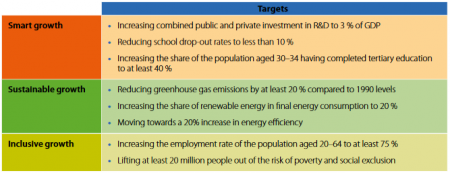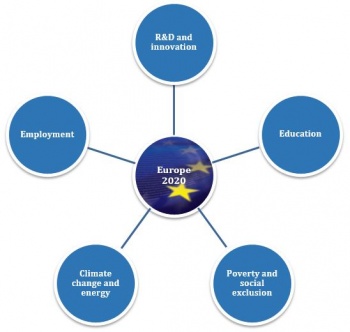Archive:Europe 2020 indicators - background
Planned article update: September 2019.
This article is part of a set of statistical articles on the Europe 2020 strategy. It introduces the Europe 2020 strategy and the broader political context in which it is embedded. The articles cover the five thematic areas of Europe 2020 on employment, education, poverty and social exclusion, climate change and energy and R&D and innovation. An executive summary article outlines the main trends revealed by the Europe 2020 indicators. Additional ‘country profiles’ describe the progress of each Member State towards its national Europe 2020 targets.
<articlecontent>
Providing statistical support to Europe 2020
The 2018 edition of Eurostat’s annual ‘flagship publication’ entitled ‘Smarter, greener, more inclusive? — Indicators to support the Europe 2020 strategy’ provides statistical support for the Europe 2020 strategy, the EU’s agenda for jobs and growth for the current decade, and monitors progress towards its headline targets. The publication presents the most recent official statistics disseminated by Eurostat, with the aim of providing statistical analyses related to important European Commission policy frameworks and relevant economic, social and environmental phenomena. Impartial and objective statistical information is essential for evidence-based political decision-making and defines Eurostat’s role in the context of the Europe 2020 strategy. It involves developing and choosing relevant indicators to support the strategy, producing statistical data and assuring the indicators’ quality.
The analysis in the five thematic articles is based on the Europe 2020 headline indicators, developed to monitor the strategy’s targets. Other indicators focusing on specific subgroups of society or on related issues that show underlying trends are also used to deepen the analysis and present a broader picture. The data used mainly come from official European Social Surveys such as the EU Labour Force Survey (EU LFS) or the EU Statistics on Income and Living Conditions (EU SILC), as well as from administrative sources. Data on EU-28 aggregates and individual Member States are presented and, where available, comparisons are made with the members of the European Free Trade Association (EFTA) and EU candidate countries, as well as non-European countries such as the United States and Japan. For some of the headline indicators, maps presenting the performance of Europe’s regions and their progress towards the national Europe 2020 targets are included, even though the targets only apply on a national level.
The thematic articles analyse past trends, generally since 2002 or 2008, up to the most recent year for which data are available (2016 or 2017). They aim to document and analyse the trends shown by the headline indicators and the distance to the Europe 2020 targets. Supplementary indicators are also used to provide the broader context. Most recent data on the headline indicators and information on the Europe 2020 strategy are available on a dedicated section of Eurostat’s website: Europe 2020 headline indicators.
The Europe 2020 strategy
The Europe 2020 strategy (European Commission, 2010) was adopted by the European Council on 17 June 2010 as the successor to the Lisbon strategy. It emphasises smart, sustainable and inclusive growth as a way to strengthen the EU economy and prepare its structure for the challenges of the next decade.
Three key priorities and eight targets
The Europe 2020 strategy puts forward three mutually reinforcing priorities to make Europe a smarter, more sustainable and more inclusive place to live:
- Smart growth, through the development of an economy based on knowledge, research and innovation.
- Sustainable growth, through the promotion of resource-efficient, green and competitive markets.
- Inclusive growth, through policies aimed at fostering job creation and poverty reduction.
Under these three key priorities, the EU adopted eight targets (see Table 1).
The eight targets belong to five thematic areas: employment, education, poverty and social exclusion, climate change and energy, and R&D and innovation (see Figure 1). These five areas are strongly interlinked. For example, higher educational levels are associated with improved employability and increasing the employment rate helps to reduce poverty. A greater capacity for R&D and innovation across all sectors of the economy, combined with increased resource efficiency, would improve competitiveness and foster job creation. Investing in cleaner, low-carbon technologies would help the environment, contribute to the fight against climate change and create new business and employment opportunities (European Commission, 2010, p. 11).
The EU targets have been translated into national targets. These reflect each Member State’s situation and the level of ambition they are able to reach as part of the EU-wide effort to implement the Europe 2020 strategy. However, in some cases the national targets are not sufficiently ambitious to cumulatively reach the EU-level targets. For instance, fulfilling all national targets in the area of employment would bring the overall EU-28 employment rate up to 74 %, which would still be one percentage point below the Europe 2020 target of 75 %. (European Commission, 2014, p. 12-16).
Taking stock of Europe 2020 — how to pursue smart, sustainable and inclusive growth?
In March 2014, the Commission published a Communication ‘Taking stock of the Europe 2020 strategy for smart, sustainable and inclusive growth’. The mid-term evaluation revealed that progress towards the Europe 2020 targets had been mixed: while the EU was on course to meet its targets on education, climate and energy, it was still far from fulfilling the employment, research and development, and poverty reduction targets (European Commission, 2014, p. 21).
Taking account of Member States' different situations in the economic cycle, the 2018 Annual Growth Survey invites Member States to continue building on the 'virtuous triangle' of economic policy: boosting investment, pursuing structural reforms and ensuring responsible fiscal policies. Focus is placed on reforms to boost investment, including in human capital, and to improve the functioning of product, service and labour markets, which will increase innovation, competitiveness, productivity and long-term growth.
The European Semester: annual cycle of policy coordination
The success of the Europe 2020 strategy crucially depends on Member States coordinating their efforts. To ensure this, the European Commission has set up an annual cycle of coordination of economic policies known as the European Semester. Its main purpose is to foster structural reforms, to create more jobs and growth in line with the Europe 2020 strategy, to boost investment, to ensure sound public finances (avoiding excessive government debt) and compliance with the Stability and Growth Pact (SGP), and to prevent excessive macroeconomic imbalances in the EU.
Figure 2 presents the stages of the European Semester policy cycle. These include:
- Adoption of the Annual Growth Survey (AGS) by the European Commission, which sets out overall economic and social priorities for the EU and its Member States.
- Publication of the Commission’s Alert Mechanism Report (AMR), the draft Joint Employment Report and recommendations for the euro area, accompanied by a Staff Working Document.
- Publication of a country report by the Commission services for each Member State, analysing its economic and social situation and progress on implementing the country-specific recommendations and towards the Europe 2020 strategy. For the Member States selected in the Alert Mechanism Report, it also includes the ‘in-depth review’ of possible imbalances.
- Submission of the National Reform Programmes (NRPs) and Stability and Convergence Programmes (SCPs) by each Member State, presenting concrete reforms and measures towards implementing the country-specific recommendations and the Europe 2020 strategy.
- Adoption of the proposals for country-specific recommendations for each Member State (except those under a stability support programme) by the Commission, followed by formal Council endorsement of the country-specific recommendations. The recommendations focus on the issues which require the most urgent attention in the next 12 to 18 months due to their macro- and socio-economic significance. The recommendations are also consistent with the Europe 2020 strategy.
The ‘Reflection paper on the deepening of the Economic and Monetary Union’, adopted on 31 May 2017, includes avenues that the European Commission will consider to further reinforce the European Semester. These include:
- Foster further cooperation and dialogue with Member States, involving also national parliaments, social partners, National Productivity Boards and other stakeholders.
- Increase further the focus on the aggregate euro-area dimension, with a stronger role for the euro-area recommendations.
- Make a closer link between the yearly process of the European Semester and a multi-annual approach to reforms of national governments.
<sesection>
Europe 2020 in a broader policy perspective
Ten priorities for the EU
Before being elected president of the European Commission in July 2014, Jean-Claude Juncker presented his political agenda, highlighting ten priority areas, in a document entitled 'A New Start for Europe: My Agenda for Jobs, Growth Fairness and Democratic Change' (see Box 1).
Box 1: The ten European Commission priorities:
- A new boost for jobs, growth and investment
- A connected digital single market
- A resilient Energy Union with a forward-looking climate change policy
- A deeper and fairer internal market with a strengthened industrial base
- A deeper and fairer Economic and Monetary Union (EMU)
- A balanced and progressive trade policy to harness globalisation
- An area of Justice and Fundamental Rights based on mutual trust
- Towards a new policy on migration
- Europe as a stronger global actor
- A Union of democratic change.
The 2018 Commission work programme ‘An agenda for a more united, stronger and more democratic Europe’ sets out concrete actions and proposals for completing the work on President Juncker's ten political priorities before the end of its mandate, as well as a series of forward-looking initiatives for the future of Europe. To boost jobs, growth and investment, the Commission will pursue work to deliver on the Circular Economy Action Plan and to complete the Digital Single Market, the Energy Union, the Capital Markets Union, the Economic and Monetary Union, and the Banking Union. An initiative on fair taxation in the digital economy, a social fairness package and a proposal to improve the EU food supply chain will all contribute to a deeper and fairer internal market with a strengthened industrial base. There will also be targeted new measures to complete the Security Union and deliver on the EU Agenda on Migration and the Global Strategy, and to strengthen the Union Civil Protection Mechanism. The Commission will pursue its balanced and progressive trade policy to harness globalisation by finalising agreements with Japan, Singapore and Vietnam, and will pursue negotiations with Mexico and the South American free-trade bloc Mercosur.
Reinforcing economic governance
In June 2015, the President of the European Commission, in cooperation with the President of the Euro Summit, the President of the Eurogroup, the President of the European Central Bank and the President of the European Parliament, presented a report titled ‘Completing Europe's Economic and Monetary Union’, also known as the Five Presidents’ Report [1]. It proposed a roadmap for strengthening the Economic and Monetary Union (EMU) by taking actions on four fronts: economic, financial, fiscal and political.
As a follow-up to the Five President’s report, the European Commission issued a Communication ‘On steps towards completing the Economic and Monetary Union’. It laid out a plan for strengthening the European Semester by better integrating European and national dimensions, placing a stronger focus on employment and social performance, promoting convergence by benchmarking and pursuing best practices, and by supporting structural reforms through the provision of EU funds and technical assistance.
In December 2017, the European Commission published a Communication on ‘Further steps towards completing Europe’s economic and monetary union: A roadmap’. The Roadmap is accompanied by four other main initiatives: a proposal to establish a European Monetary Fund (EMF), anchored within the EU's legal framework; a proposal to integrate the substance of the Treaty on Stability, Coordination and Governance into the Union legal framework; a Communication on new budgetary instruments for a stable euro area within the Union framework; and a Communication spelling out the possible functions of a European Minister of Economy and Finance.
Strengthening the EU’s social dimension
While the design and implementation of social policy remains principally a responsibility of national governments, the EU plays an important role in supporting and complementing their efforts.
On 17 November 2017, at the Social Summit for Fair Jobs and Growth in Gothenburg, the Council and the European Commission jointly signed the European Pillar of Social Rights. The Pillar establishes a set of 20 principles and rights, which are to serve as a reference framework for employment and social policy at the national and European levels. These are structured around three categories: equal opportunities and access to the labour market, fair working conditions, social protection and inclusion.
The 2018 Annual Growth Survey puts the Pillar at the forefront by prioritising reforms that aim to help the labour force acquire skills, promote equal opportunities in the labour market and fair working conditions, increase labour productivity to support wage growth, and promote adequate and sustainable social protection systems. In addition to proposing the European Pillar of Social Rights, the Commission has put forward a number of legislative and non-legislative initiatives related to work-life balance, working conditions, access to social protection and working time.
White Paper on the future of Europe and follow-up Reflection Papers
At the Rome Summit on 1 March 2017 the Commission presented a White Paper setting out a broader vision for the EU’s future. The paper outlines the main demographic, economic and political challenges the EU will face in the future and presents five scenarios of the potential state of the Union in 2025:
Scenario 1: Carrying On — The EU-27 focuses on delivering its positive reform agenda.
Scenario 2: Nothing but the Single Market — The EU-27 is gradually re-centred on the single market.
Scenario 3: Those Who Want More, Do More — The EU-27 allows willing Member States to do more together in specific areas.
Scenario 4: Doing Less, More Efficiently — The EU-27 focuses on delivering more and faster in selected policy areas, while doing less elsewhere.
Scenario 5: Doing Much More Together — Member States decide to do much more together across all policy areas.
The White Paper has been supplemented by five reflection papers on specific issues important for the future of the EU: the social dimension of Europe, harnessing globalisation, the deepening of the economic and monetary union, the future of European defence and the future of EU finances. A sixth reflection paper 'Towards a sustainable Europe by 2030' was announced in the Commission Work Programme for 2018.
The 2030 Agenda for sustainable development
In a global context, the Europe 2020 strategy plays an important role in addressing the internationally adopted 2030 Agenda for Sustainable Development and thus putting the European Union on the right track to achieving a sustainable future.
The 2030 Agenda was formally adopted by world leaders at the United Nations Sustainable Development Summit in September 2015. The document, titled ‘Transforming our world: the 2030 Agenda for sustainable development’, consists of a declaration, a set of 17 Sustainable Development Goals (SDGs) and 169 related targets, a section on the means of implementation and on the follow-up and review of the 2030 Agenda. A 'global indicator framework', containing 232 indicators, was adopted by the UN General Assembly in July 2017.
In November 2016, the European Commission released the Communication ‘Next steps for a sustainable European future: European action for sustainability’ which was accompanied by a first statistical publication ‘Sustainable development at a glance’ by Eurostat. A year later, Eurostat published the first edition of the annual EU SDG monitoring report ‘Sustainable development in the European Union — Monitoring report on progress towards the SDGs in an EU context’, which is based on the EU SDG indicator set and includes more background information.
See also
Further Eurostat information
Publications
- Smarter, greener, more inclusive - indicators to support the Europe 2020 strategy - 2018 edition (online publication, also downloadable as PDF file
Main tables
Dedicated section
Methodology / Metadata
- Towards robust quality management for European Statistics - Communication from the Commission to the European Parliament and the Council COM(2011) 211 final.
Other information
- Regulation (EC) No 223/2009 of 11 March 2009 on European statistics
External links
Notes
- ↑ The report was prepared by the president of the European Commission, in cooperation with the presidents of the Euro Summit, the Eurogroup, the European Central Bank and the European Parliament.





